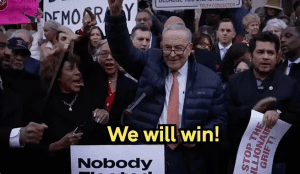 As the first month of President Donald Trump’s second term unfolds, Democrats find themselves scrambling to mount a coherent response. Trump, unlike any president before him, has taken office with an unprecedented sense of urgency, aggressively fulfilling his campaign promises at a breakneck pace. This has left the Democratic Party, already bruised from an unexpectedly poor electoral performance, struggling to recalibrate and craft an effective opposition strategy.
As the first month of President Donald Trump’s second term unfolds, Democrats find themselves scrambling to mount a coherent response. Trump, unlike any president before him, has taken office with an unprecedented sense of urgency, aggressively fulfilling his campaign promises at a breakneck pace. This has left the Democratic Party, already bruised from an unexpectedly poor electoral performance, struggling to recalibrate and craft an effective opposition strategy.
Unlike his initial term, which was marked by internal White House chaos and external resistance, Trump’s second term has begun with a clear sense of mission. His administration is operating with the singular goal of fulfilling his campaign pledges, particularly on government efficiency, economic nationalism, and regulatory rollback. While previous presidents often faced bureaucratic inertia and the complications of bipartisan negotiation, Trump has instead chosen to act decisively, often via executive orders, circumventing the legislative gridlock that has historically slowed governance.
One of the most significant and controversial moves of his early presidency has been the creation of the Department of Government Efficiency (DOGE), headed by billionaire entrepreneur Elon Musk. DOGE has been charged with identifying and eliminating waste within federal agencies, leading to a large-scale restructuring of government departments. Their efforts have already uncovered billions of dollars in redundant spending, prompting a wave of layoffs and reorganizations across various government institutions.
The Democratic response has been notably fractured and, at times, ineffective. Party leaders have largely framed Trump’s actions as unconstitutional or unlawful, emphasizing procedural violations rather than contesting the substance of his policies. However, this approach has placed them in the difficult position of appearing to defend government excess and inefficiency—an argument that does not resonate well with the general public.
Furthermore, the Democratic Party remains divided between its progressive and centrist factions. The progressive wing, emboldened by their influence in the party, has pushed for more aggressive resistance, while centrists are wary of alienating moderate voters. This schism has paralyzed their ability to present a united front, with their messaging appearing inconsistent and reactionary rather than proactive.
One of the most striking aspects of the current political landscape is the public’s reaction to Trump’s governance. Unlike during his first term, when his policies were met with fierce and organized opposition, there is now a noticeable shift in public perception. Many Americans, particularly independents and moderate conservatives, see Trump’s swift action as a refreshing change from the stagnation and inefficiency that often characterize Washington politics. The discovery of massive government waste has further galvanized public support for his administration’s initiatives, putting Democrats in an increasingly difficult position.
Moreover, the mainstream media, once a formidable opponent of Trump, has lost much of its credibility with large swaths of the electorate. The constant allegations of misinformation and media bias over the past decade have left many Americans skeptical of traditional news sources, further weakening the Democrats’ ability to use the media as a tool for opposition.
Looking ahead to the 2026 midterm elections, the Democratic Party faces a significant challenge. If they continue to frame their opposition solely on legalistic grounds without offering substantive policy alternatives, they risk further alienating moderate and independent voters. This could lead to another electoral setback, further entrenching Republican dominance in Washington.
To regain their footing, Democrats must shift their strategy from reactive opposition to proactive policy advocacy. Rather than focusing solely on Trump’s alleged violations of norms and procedures, they need to present a compelling vision of governance that addresses the concerns of everyday Americans. Whether they can successfully navigate this turbulent political climate remains to be seen, but one thing is clear—if they fail to adapt, they risk further political marginalization.